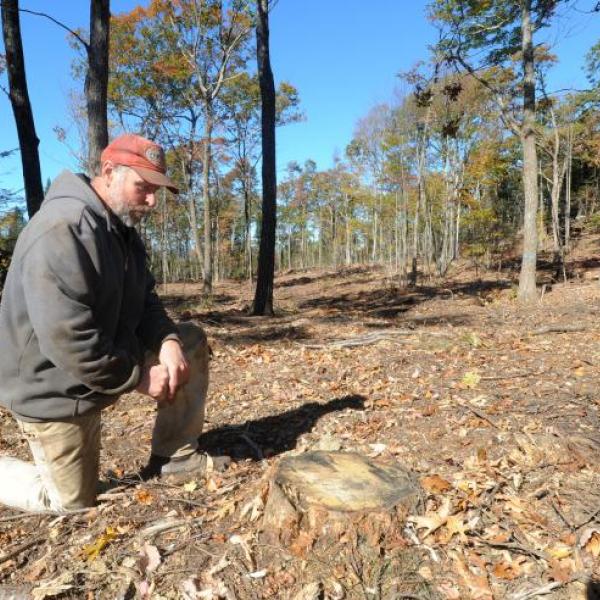
News Source
By DIANE BRONCACCIO
SHELBURNE CENTER, Massachusetts — It was only a year ago that Norman and Lisa Davenport first noticed sunlight flickering through the once-dense shade of a stand of hemlocks on their hilltop farmland.
And now those first trees look more like utility poles than conifers.
As the twin evils of elongate hemlock scale and hemlock woolly adelgid spread through 60 to 70 acres of stately hemlock, the Davenports knew they had to take action to stem the losses.
Both are invasive, microscopic insects that originated from Asia and have no natural predators here. Elongate Hemlock Scale suck the sap out of the tree needles, eventually killing the tree. Once the scale density reaches about 10 bugs per needle, there may be dieback of limbs.
Hemlock woolly adelgid is an aphid-like insect less than 1/16 of an inch long, according to the US Department of Agriculture, and can be spread by wind, birds, deer and other forest-dwelling mammals. The adelgid feeds on starches and can kill off a hemlock within four to 10 years — especially south of Massachusetts, where warmer winters don’t kill them off. But for hemlocks with both conditions, the mortality rate is faster.
Today, the forested Mount Massaemet has a “crew cut,” where trees infested by these invasive insects have been cut down. Because part of the cleared forest lies along a popular hiking trail going up to the Shelburne Fire Tower, the Davenports want the public to know that the tree-cutting was part of a responsible forest management plan. Throughout the clearing, a few healthy hemlocks were spared and left to grow, along with a few deciduous trees, all marked before the cutting began. Norm Davenport calls this “a regeneration cut,” in which enough trees are left so that the trees can reseed.
“This has been a good year for acorns,” Davenport remarked, and many may have been plowed under the soft rich soil by the heavy harvesting equipment. He thinks the new canopy will have many more oak trees when it fills in.
“It will grow back,” Norm Davenport says of the cleared area. “In five years, the regrowth will be up over your head, and it will be wonderful for wildlife. But it will come back as mixed hardwood — mostly oak.”
To address the problem, the Davenports hired a forester to create a 10-year forest management plan, which was then submitted to the state Department of Conservation and Recreation.
DCR Service Forester Alison Wright-Hunter reviewed the Davenports’ plan, along with their forest-cutting plan. Wright-Hunter said a forest-cutting plan for such a large swath of woods is no longer uncommon.
“The hemlocks were dying up there,” Wright-Hunter remarked, “and before they all died, Norm wanted to harvest them while they were of some value. The idea is so you’re not left with a stand of dead trees; you sell product back into a market, which society needs.”
Davenport said the “good” trees that were harvested were sold for timber or to paper mills. But most of the hemlock was chipped for biomass. Any hardwood that wasn’t logged for timber was sent to a New Hampshire plant to be made into wood pellets for heating fuel.
A fungus called sirococcus tip blight has also been killing hemlocks along the Route 2 corridor, according to Kenneth Gooch, DCR director of forest health programs. Gooch said the fungus, carried from one forest to another on birds’ feet and wings, affects the new growth of tree needles and can kill hemlocks faster that have the insect infestations.
“Conifers have to grow out a little each year, because they can only hold (the old) needles for three or four years,” he said. He explained that new needle growth nourishes the tree and replaces older-growth needles that eventually fall out. If the tips of the hemlock branches are blighted by the fungus, the tree dies more quickly as the old needles come off.
“There’s a multitude of factors,” he said. “(Massachusetts) Fish and Wildlife sometimes do these large opening if they have a stand (of trees) up there and they see a lot of decline.” Gooch said sometimes the clearing creates a new habitat that brings in more birds or other types of trees.
Davenport said the hemlock was not a high-value tree on that property. “When you’re harvesting sick trees, the value isn’t worth the cost of the harvesting. The cost of the labor and equipment is very close to what you get in return.”
Davenport said the value of the new trees that grow back over the next few decades will benefit his children and grandchildren — just as the maple trees that his father, Russell Davenport, planted 30 years ago are now been tapped to produce the farm’s maple syrup.